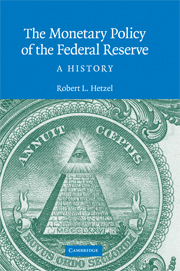Book contents
- Frontmatter
- Contents
- Figures
- Preface
- 1 The Pragmatic Evolution of the Monetary Standard
- 2 Learning and Policy Ambiguity
- 3 From Gold to Fiat Money
- 4 From World War II to the Accord
- 5 Martin and Lean-against-the-Wind
- 6 Inflation Is a Nonmonetary Phenomenon
- 7 The Start of the Great Inflation
- 8 Arthur Burns and Richard Nixon
- 9 Bretton Woods
- 10 Policy in the Ford Administration
- 11 Carter, Burns, and Miller
- 12 The Political Economy of Inflation
- 13 The Volcker Disinflation
- 14 Monetary Policy after the Disinflation
- 15 Greenspan's Move to Price Stability
- 16 International Bailouts and Moral Hazard
- 17 Monetary Policy Becomes Expansionary
- 18 Departing from the Standard Procedures
- 19 Boom and Bust: 1997 to 2001
- 20 Backing Off from Price Stability
- 21 The Volcker–Greenspan Regime
- 22 The Fed: Inflation Fighter or Inflation Creator?
- 23 The Stop–Go Laboratory
- 24 Stop–Go and Interest Rate Inertia
- 25 Monetary Nonneutrality in the Stop–Go Era
- 26 A Century of Monetary Experiments
- Appendix: Data Seen by FOMC for the Stop–Go Period Shown in Figures 24.1, 24.2, and 24.3
- Notes
- Bibliography
- Index
- Titles in the series
16 - International Bailouts and Moral Hazard
Published online by Cambridge University Press: 26 May 2010
- Frontmatter
- Contents
- Figures
- Preface
- 1 The Pragmatic Evolution of the Monetary Standard
- 2 Learning and Policy Ambiguity
- 3 From Gold to Fiat Money
- 4 From World War II to the Accord
- 5 Martin and Lean-against-the-Wind
- 6 Inflation Is a Nonmonetary Phenomenon
- 7 The Start of the Great Inflation
- 8 Arthur Burns and Richard Nixon
- 9 Bretton Woods
- 10 Policy in the Ford Administration
- 11 Carter, Burns, and Miller
- 12 The Political Economy of Inflation
- 13 The Volcker Disinflation
- 14 Monetary Policy after the Disinflation
- 15 Greenspan's Move to Price Stability
- 16 International Bailouts and Moral Hazard
- 17 Monetary Policy Becomes Expansionary
- 18 Departing from the Standard Procedures
- 19 Boom and Bust: 1997 to 2001
- 20 Backing Off from Price Stability
- 21 The Volcker–Greenspan Regime
- 22 The Fed: Inflation Fighter or Inflation Creator?
- 23 The Stop–Go Laboratory
- 24 Stop–Go and Interest Rate Inertia
- 25 Monetary Nonneutrality in the Stop–Go Era
- 26 A Century of Monetary Experiments
- Appendix: Data Seen by FOMC for the Stop–Go Period Shown in Figures 24.1, 24.2, and 24.3
- Notes
- Bibliography
- Index
- Titles in the series
Summary
In 1995, the treasury led an IMF bailout of foreign investors in Mexico. The bailout set off a chain of destabilizing events. The amount of money potentially made available to prevent default by Mexico on dollar-denominated debt made banks willing to hold large amounts of short-term debt in U.S. allies. That debt made possible the Asia crisis. Banks made what looked like sure one-way bets in lending to Asian banks and then abandoned them en masse when currency devaluations caused insolvencies large enough to threaten the international safety net. The FOMC responded to the Asia crisis with expansionary monetary policy, which exacerbated an unsustainable rise in asset prices. The fall of lofty equity valuations created the 2000 recession.
The Mexico Bailout
By late 1994, the Mexican peso had become overvalued due to an unwillingness of the Mexican government to allow the exchange rate to depreciate sufficiently to compensate for domestic inflation. From 1990Q1 through 1994Q3, the Mexican CPI doubled. Over this same period, the U.S. price level rose by 18% and the peso price of the dollar rose by 30%. The combined rise of these last two variables, 48%, offset just less than half of the rise in the Mexican price level. By the end of 1994, U.S. goods looked 50% cheaper to Mexicans than they did at the beginning of the 1990s. Mexicans responded to the relative cheapening of U.S. goods by going on a shopping spree in the United States.
How did Mexico maintain an overvalued exchange rate?
- Type
- Chapter
- Information
- The Monetary Policy of the Federal ReserveA History, pp. 206 - 217Publisher: Cambridge University PressPrint publication year: 2008

